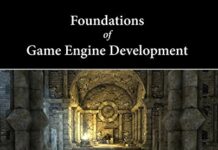
Ebook Info
- Published: 2011
- Number of pages: 624 pages
- Format: PDF
- File Size: 4.55 MB
- Authors: Eric Lengyel
Description
This updated third edition illustrates the mathematical concepts that a game developer needs to develop 3D computer graphics and game engines at the professional level. It starts at a fairly basic level in areas such as vector geometry and linear algebra, and then progresses to more advanced topics in 3D programming such as illumination and visibility determination. Particular attention is given to derivations of key results, ensuring that the reader is not forced to endure gaps in the theory. The book assumes a working knowledge of trigonometry and calculus, but also includes sections that review the important tools used from these disciplines, such as trigonometric identities, differential equations, and Taylor series.The third edition expands upon topics that include projections, shadows, physics, cloth simulation, and numerical methods. All of the illustrations have been updated, and the shader code has been updated to the latest high-level shading language specifications.
User’s Reviews
Editorial Reviews: About the Author Eric Lengyel is a veteran of the computer games industry with over 16 years of experience writing game engines. He has a PhD in Computer Science from the University of California at Davis and an MS in Mathematics from Virginia Tech. Eric is the founder of Terathon Software, where he currently leads ongoing development of the C4 Engine.
Reviews from Amazon users which were colected at the time this book was published on the website:
⭐As a word of warning, do not purchase this book expecting it to teach you math fundamentals. If you do not have a background of at least algebra and trigonometry (and preferably a bit of calculus), you owe it to yourself to pick up another book and brush up on these fundamentals. While there are a few appendices covering a handful of topics, they are less about explaining the topic and more of reference pages.Mathematics for 3D Game Programming and Computer Graphics is an excellent reference book for anyone doing 3D work. The topics are very to the point and few pages are wasted explaining basic math principles (hence the warning about having a decent math background). The book probably won’t teach anyone who doesn’t know they underlying principles but will be your go-to reference for any algorithm you implement.The book starts with the reviews of the requisite vector, matrix, transformation (including rotations by quaternions) and basic geometry for a view frustum, but quickly dives into more advanced topics. Ray tracing is covered for all areas of use, from light maps to reflections. The lighting chapter covers texturing using several map types as well as lighting models with a very enjoyable discussion of specular reflection models.Solid chapters on culling using bounding volumes and portal systems, shadowing and curve algorithms round out the first half of the book. The second half is devoted to the mathematics of physics, with chapters on basic collision detection, linear and rotational physics. The simulation of fluids and cloth (one of the more difficult physical models to accurately compute in a game) gets it’s own chapter and it’s a highlight for anyone implementing character clothing animation or a realistic water volume.Every chapter has exercises (with and appendix of answers) to reinforce the material. The C++ and GLSL shader code is available on the books companion website ([…]) much of which forms the basis for the math classes of the authors own engine.Anyone who needs a math reference book for 3D would do well to own this book. If you are writing your own engine, you owe it to yourself to pick up what will be the only math book you will need. While many technical books do not age well, this hardcover book will last through many late-night coding sessions both physically and with regard to the material within at a low price point. Never again will you have to scour through your old textbooks or search online for the algorithm you are trying to implement. The author has done the impossible; make a truly terrific math textbook.
⭐Mathematics for 3D Game Programming and Computer Graphics by Eric Lengyel is one of those books I have literally been eyeing for years and just never got around to reading. If you are not familiar, Eric Lengyel is the creator of the C4 Engine, and also the author of various game development books. He is well regarded in the community, so I assumed this was a must read title. After reading it, I still agree; it’s an excellent source of knowledge.The book covers the basic stuff you would expect from a 3D math book: vectors, matrices, quaternions, intersections between various types of geometry, visibility, etc. Great, so the bases are covered. Lengyel goes a bit further, though, and discusses other topics that are very important in computer graphics. For example: lighting and shadowing, decals, curved surfaces, and physics (including fluid and cloth simulation). So a decent amount of topics are covered, but the chapters are still brief enough to finish each in one sitting.While there are some implementation examples, the text is pretty light on the code. The code that is here is mostly based around OpenGL, however the concepts should still translate to DirectX. Not a huge issue. When needed, he does show code samples, but most of the copy is dedicated to math discussion and the equations.Granted, some of the equations and proofs were dense and hard to follow. This was made worse by the fact that I was reading this on the Kindle, and the equations were made up of small images you couldn’t zoom in on. Having said that, I still understood most of the concepts, but there were a few times I felt overwhelmed. I can’t really fault the author for that, since his written explanations were all very clear and concise. It’s just some of the content is deep and complex, so be prepared.All in all, I found this to be a great resource and you can never know enough math in this field. Unfortunately, I will still probably have to look up some of the equations online or in other books due to the low quality of the images in the e-book. But this is a minor complaint compared to the amount of information backed in this title. I would recommend this.
⭐I have seen some of the mathematics for modelling physical models listed in other books but never comprehensively collected as it has been here. Also, this book has the best explanation of matrix multiplication for model rotation that I have ever seen in a book. Some C code is included to show how to get the mathematics to work on a computer, but the code is minimal and you need to have a few years of programming experience to transfer the lessons shown here into a practical programming.I also want to give the book a huge plus for showing how to use Quaternions for vector rotation in the chapter(4) on vector transforms. If you want to avoid the evil “gimbal lock event” from jamming your model’s rotation, this is the best way to program your model to turn.There are 16 chapters and 2 appendices that can give you a solid understanding of how to be a great computer modeler. In 530 pages you have everything you need to make your birds look real and fly in flocks, make your rail car rise up and accelerate down the track, or animate a rock warrior in battle and make him explode or dissolve convincingly.To make use of the mathematics contained here you will probably need a GPU to run your animations and you will need to program in OpenCL or CUDA to get the animations running quickly in DirectX or OpenGL .This is about two college semesters of study contained between the covers, but if you want to be great you have to get serious about knowing your craft.
⭐I’m not a professional programmer rather an enthusiastic amateur. This is not a book for beginners.Although there is a good review of linear algebra in the first part, some previous experience with linear algebra is essential to get the most out of this book in my opinion,That said, I love this book. If you’re looking for a good grounding in 3D graphics you cant go far wrong.
⭐I haven’t read such a good book for ages.The layout of the book is very clear and intuitive. You can easily find subjects you are looking for. Good graphics, examples and mathematical techniques make this book very useful for everyone who would like to learn more about 3D graphics and game programming.Highly recommended.
⭐Great book, but some of the pages are slightly distorted
⭐I bought this product for my nephew who thinks it’s absolutely fantastic. 10/10.
⭐Well Recommender
Keywords
Free Download Mathematics for 3D Game Programming and Computer Graphics, Third Edition 3rd Edition in PDF format
Mathematics for 3D Game Programming and Computer Graphics, Third Edition 3rd Edition PDF Free Download
Download Mathematics for 3D Game Programming and Computer Graphics, Third Edition 3rd Edition 2011 PDF Free
Mathematics for 3D Game Programming and Computer Graphics, Third Edition 3rd Edition 2011 PDF Free Download
Download Mathematics for 3D Game Programming and Computer Graphics, Third Edition 3rd Edition PDF
Free Download Ebook Mathematics for 3D Game Programming and Computer Graphics, Third Edition 3rd Edition



